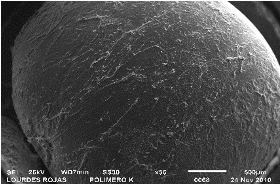 |
|
Three solid polymers; Kraton, Elvax, and Desmopan, previously suggested to be used in three-phase reactors, were evaluated for their ability to enhance oxygen transfer in a bubble column. These vectors were first characterized through determination of particle size distribution, surface roughness, specific surface area, density, void fraction and thermal stability. Oxygen transfer was then determined with a non-coalescing medium using polymer volume fractions from 0 to 75% in a 4 L bubble column operated at air flow rates ranging from 1 to 6 L/min. The results showed that the oxygen transfer was significantly improved in presence of 10 and 25% of Kraton and Elvax, compared with control experiment with no polymer. A maximum oxygen transfer improvement of 90%, compared with control, was observed with 10% Kraton. With Desmopan, no positive effect on oxygen transfer was observed regardless of the vector percentage used. Phase’s dispersion and oxygen transfer was further explored in presence of 10% Kraton. Gas holdup, Sauter mean bubble diameter and vector dispersion were characterized by means of high speed digital image analysis. The results showed that the enhancement of oxygen transfer mediated by Kraton was mainly caused by an increase of gas holdup and consequently of the gas/liquid surface area.
Keywords: bubble size, gas holdup, interfacial area, non-aqueous phases, TPPB.
|
|
 |

